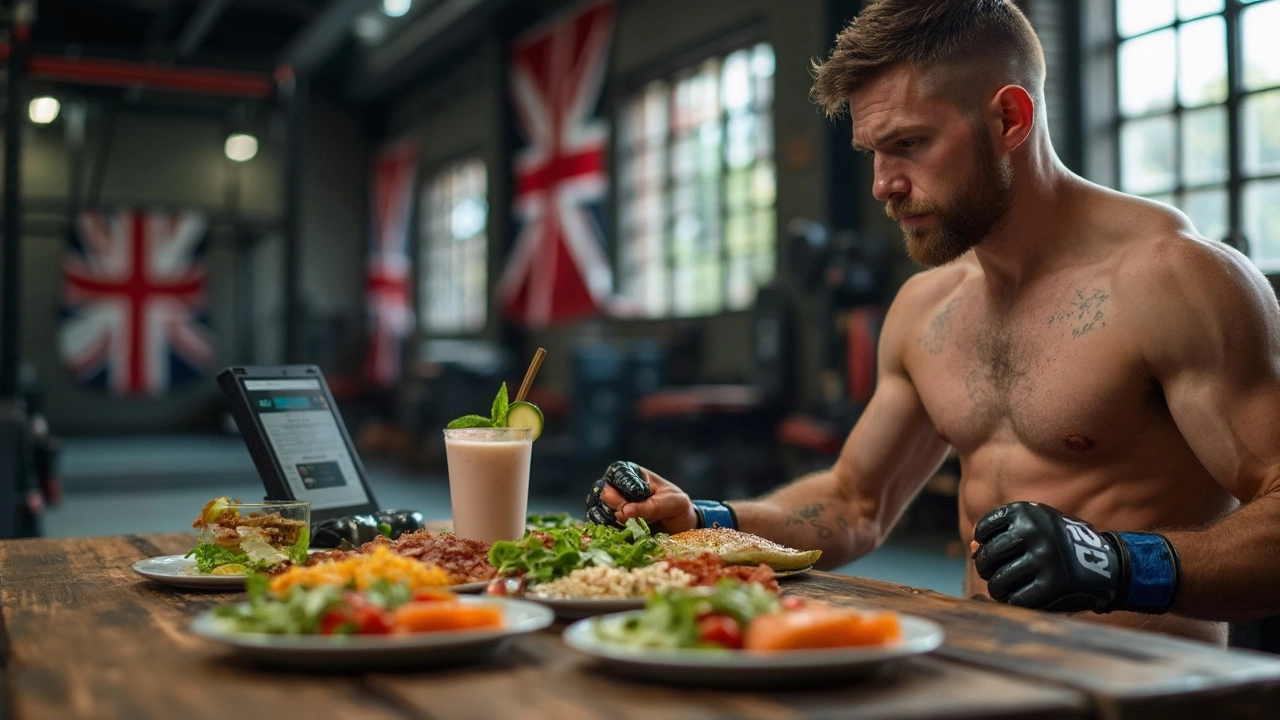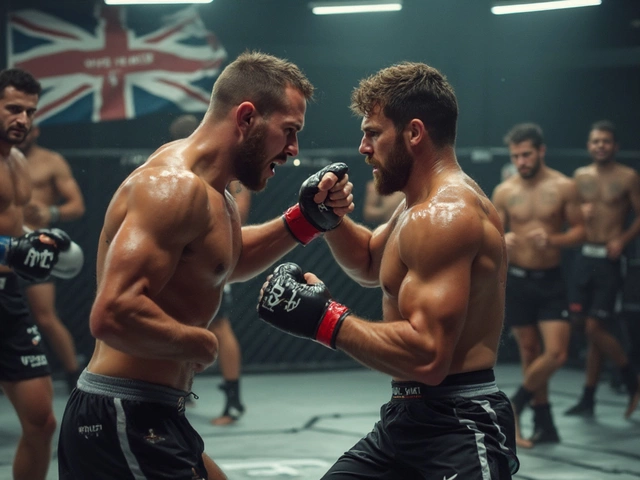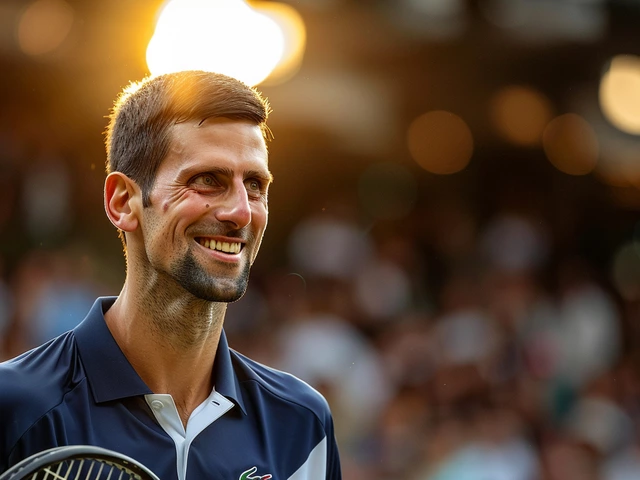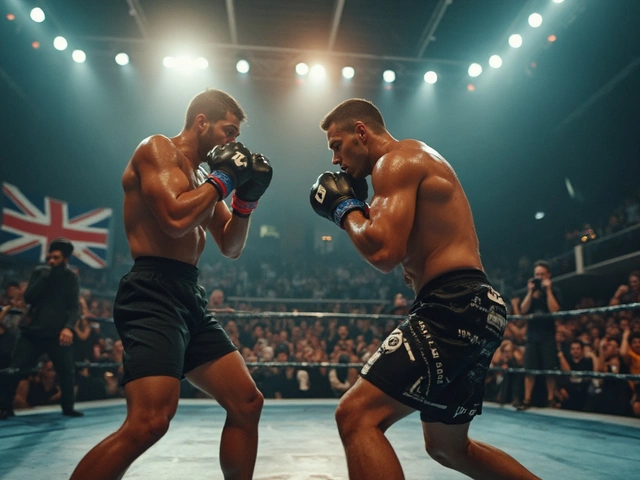Think those shredded MMA and UFC fighters are just born tough? Nah, it’s way more about what’s on their plate. Every meal they eat is about getting lean, staying strong, and ticking off weight goals before the next big fight. Whether you’re a die-hard fan obsessed with the latest news in MMA and UFC, or just getting curious thanks to the upcoming fights in MMA and UFC, the way fighters eat can tell you a lot about what happens in and out of the cage.
Some fighters live on high-protein meals—chicken, fish, eggs, and protein shakes. Others keep it simple with rice, sweet potatoes, fresh veggies, and fruit. But there’s no cookie-cutter diet. And when weight cutting kicks in? That’s when things get crazy—don’t be shocked if you hear stories about athletes living off salty water, lemons, and tiny sips of carbs just to make weight, then bouncing back with a feast right after.
If you’re thinking about how to start MMA and UFC training, what your favorite fan favorites in MMA and UFC eat matters because food is as much a weapon as a punch or kick. Ignore what you see in movies—real fighters know it’s all about fueling up, fighting smart, and learning the hard way from past mistakes. You can bet that the diet plans of MMA and UFC athletes are just as epic (and sometimes as brutal) as the most brutal MMA and UFC moments and the best knockouts in MMA and UFC history.
- What MMA and UFC Fighters Really Eat
- Meal Timing and Weight Cuts: Secrets and Struggles
- Training Fuels: What to Eat Before and After Workouts
- Fighter Stories: Diets from Legends and Rising Stars
- Hot Topics: Recent Scandals and Trends in Dieting
- Simple Tips for Fans, Newbies, and Future Fighters
What MMA and UFC Fighters Really Eat
If you’ve ever watched a weigh-in and wondered how these athletes can bounce from looking totally drained to absolute beasts on fight night, a lot of that magic comes down to what they eat (and when they eat it). Forget those fancy, restrictive diets from mainstream fitness fads—fighters build their food choices around real results and brutal training schedules.
The average pro in the UFC or top MMA circuit doesn't just count calories—they chase macros. That means dialing in the right split of protein, carbs, and fats, sometimes down to the gram. A typical fight camp might look like this:
- Protein: Chicken breast, lean beef, eggs, bison, fish (salmon is a favorite because of those healthy fats)
- Carbs: White rice, brown rice, potatoes, sweet potatoes, oats, bananas, and sometimes even gummy bears right after training for fast sugar
- Fats: Avocado, nuts, olive oil, natural peanut butter
- Veggies: Spinach, broccoli, bell peppers, mixed greens—always for vitamins and gut health
- Hydration: Coconut water, electrolyte drinks, tons of regular water
According to George Lockhart, one of the most-respected nutritionists in the fight game, keeping it simple and consistent is key:
“If you want to train like a champion, you have to eat like a champion—boring works. The fanciest diet is useless if you can’t perform.”
Now, fighters need more than just muscle—they need endless energy for long training days, explosive power for those best knockouts in MMA and UFC, and quick recovery for back-to-back sessions. Here’s a peek at a basic daily breakdown for a 170-pound UFC welterweight preparing for a fight camp:
| Meal | Food | Purpose |
|---|---|---|
| Breakfast | Oats, eggs, fruit | Fuel for the first workout |
| Snack | Protein shake, banana, peanut butter | Quick recovery after session |
| Lunch | Grilled chicken, rice, spinach | Energy for sparring or pads |
| Snack | Greek yogurt, nuts, honey | Pre-strength boost |
| Dinner | Salmon, sweet potato, broccoli | Repair muscles overnight |
The MMA diet isn’t about muscle-building shakes alone. Jason “Mayhem” Miller once joked that, “If I ate like some bodybuilders, I’d collapse halfway through sparring.” That’s the real difference: fighters eat for endurance and speed, not just size.
One weird but true thing: a lot of fighters eat almost the same thing every single day during camp. It keeps their bodies guessing less, and cuts down on stomach issues. Remember, the stakes are high—when betting odds for MMA and UFC fights get posted, what a fighter ate that week can tip the scale, literally and figuratively.
Meal Timing and Weight Cuts: Secrets and Struggles
If you’ve ever wondered how fighters drop ten pounds in a week and still look jacked, here’s the real deal: it’s a brutal mix of science, planning, and sometimes a little misery. Meal timing isn’t just a suggestion for MMA and UFC athletes—it’s a survival skill. The way they eat before, during, and after training can make or break a fight camp.
Most fighters eat their biggest meal after their hardest workout, when the body is begging for fuel. You’ll see a lot of smaller meals earlier in the day—think eggs and oats for breakfast, rice and lean meat for lunch, then a heavier dinner after evening training. Snacks like bananas, nuts, or protein shakes fill in the gaps, keeping energy steady without blowing up the scale.
But the real wild ride is the weight cut. Making weight for a fight can mean dropping 5-15% of your body weight in just a few days. UFC lightweight Islam Makhachev, for example, has talked about losing over 15 pounds in fight week—mostly water. Fighters rely on dehydration tricks, insane sweat sessions, and super-tight control of carbs and salts just to hit the number at weigh-ins. The process takes a toll, both physically and mentally.
| Weight Class | Average Loss |
|---|---|
| Flyweight | 6-10 |
| Lightweight | 10-15 |
| Welterweight | 12-18 |
| Middleweight | 15-20 |
What separates the best from the rest is how well they bounce back. Fighters rehydrate carefully right after the weigh-in—sipping fluids with electrolytes and getting carbs and proteins back in fast. Mess this up, and you could gas out before round two. Some famous knockouts and the MMA diet disasters come from botched weight cuts.
- Stick to small, balanced meals: Don’t eat huge portions that slow you down.
- Hydrate smart: Don’t just chug gallons of water. Fighters use electrolyte mixes and time their intake carefully.
- Don’t crash diet last minute: Fighters with career longevity start their cuts weeks ahead, losing fat—not just water.
- Listen to the pros: Upcoming fights in MMA and UFC usually feature fighters sharing stories of tough weight cuts—tap into those for learning.
This is not just a struggle once a year—it happens before every fight, and it’s why you see recent scandals in MMA and UFC about fighters missing weight or getting hospitalized. The timing, planning, and recovery are as important as throwing a knockout punch.
Training Fuels: What to Eat Before and After Workouts
Ever wonder how the pros keep their energy up for those crazy double sessions? What MMA and UFC fighters eat before and after training isn’t rocket science, but the details matter. Eating right around workouts decides if you’re strong in the cage or stuck dragging your feet.
Most fighters load up with a blend of carbs and protein before a big workout. Carbs give your muscles quick power—they’re like tossing gasoline on a fire. Think plain rice, oatmeal, bananas, or even a simple PB&J sandwich. Then there’s protein. Eggs, lean chicken, or a scoop of whey get muscles primed for action. A lot skip the heavy fats before practice so they don’t feel sluggish or bloated on the mats.
Here’s what a common pre-workout meal might look like for fighters:
- 1 cup cooked rice or sweet potato
- 4-6 oz lean chicken or fish
- Steamed broccoli or spinach
- 1 banana or half a mango
Timing is key. Most fighters eat this 60 to 90 minutes before training, letting food settle but leaving enough energy for power moves.
Right after sparring or a heavy gym session, it’s all about recovery. The body craves protein to fix beat-up muscles and more carbs to refill those energy tanks. A fast option is a protein shake with fruit, but a real plate is even better if there’s time. GSP, one of the legends of MMA and UFC history, once shared he swears by grilled salmon, quinoa, avocado, and berries for a post-training meal.
| Pre-Workout | Post-Workout |
|---|---|
| Oatmeal with berries and a boiled egg | Grilled chicken breast, rice, and veggies |
| Rice with turkey and spinach | Protein shake with banana and honey |
| Peanut butter on toast with banana slices | Salmon, sweet potato, and broccoli |
Fighters who try to cut corners—like skipping carbs or forgetting to eat after—almost always pay the price. Even small slip-ups can lead to getting tired fast, injuries, or showing up flat on fight night. And with so much riding on each fight (just look at the latest news in MMA and UFC), nobody’s taking chances.
One more tip: hydration. In those last days before a fight, when weight cuts get real, fighters sip small amounts of water paired with electrolytes so they don’t burn out. This keeps cramps and headaches at bay until weigh-in.
Bottom line: real food, smart timing, and never skipping out on what the body needs. That’s the secret sauce for every killer performance and those best knockouts in MMA and UFC everyone talks about. If you want to fuel like a pro, steal these habits—they really work.
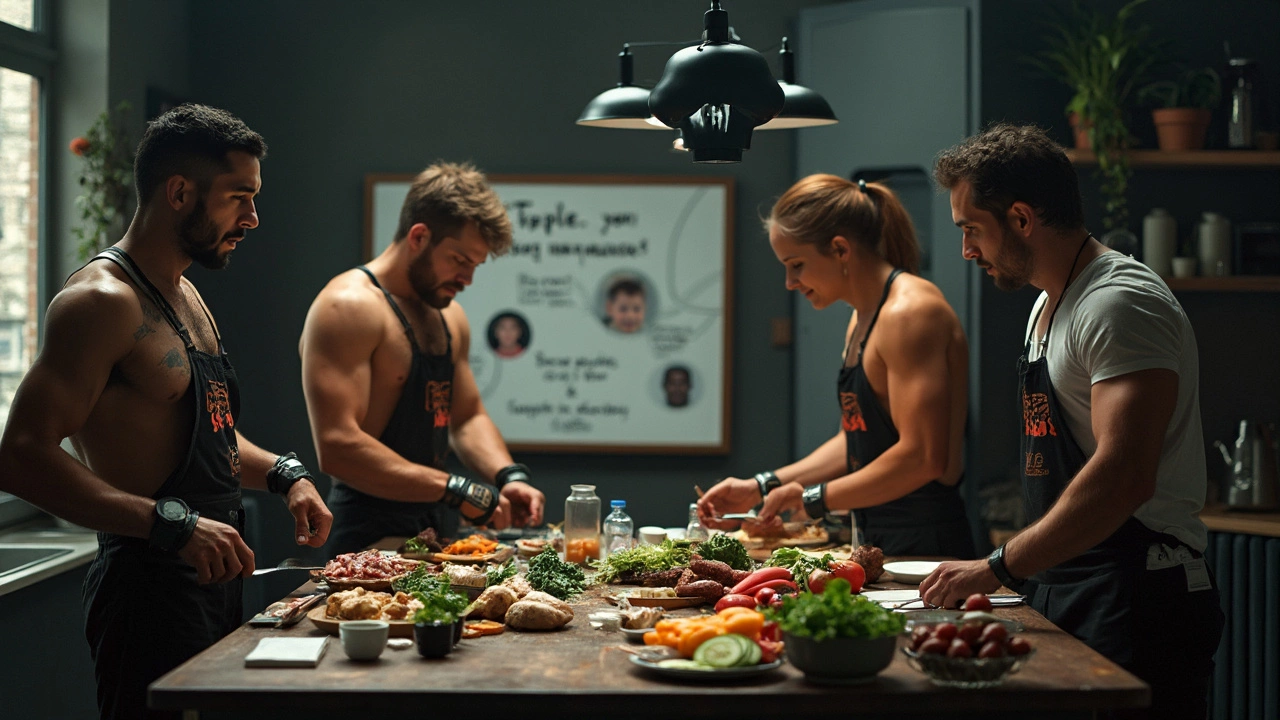
Fighter Stories: Diets from Legends and Rising Stars
When you hear about MMA diet plans, you’ll spot wild differences between the old-school legends and today’s new talent. Guys like Georges St-Pierre loved structure—he planned every calorie, weighing his oatmeal and chicken like it was pure gold. His classic meal plan leaned heavy on lean meats, greens, oats, and “clean” carbs. St-Pierre swore by eating the same breakfast every day during camp—oats, mixed berries, and eggs for that steady energy boost. Training tips from MMA and UFC fighters often stress ‘stick to the basics and don’t mess with what works.’
Now look at someone like Khabib Nurmagomedov. Khabib was big on Russian staples—lots of fish, brown rice, and a mountain of fresh veggies. No junk, no soda, and no late-night snacks. His dad coached him to avoid any street food or anything fried, especially before fights. This discipline was a huge reason why Khabib made weight fights after fights and retired undefeated. Fan favorites in MMA and UFC often owe a lot to the discipline from their background foods. It’s not always about fancy supplements.
Let’s jump ahead to the new wave—take Israel Adesanya. He’s open about loving sushi and sometimes cheats with pizza, but when camp starts, he’s all business. His plate gets crowded with salmon, sweet potatoes, brown rice, and sometimes even bone broth for joint health. Adesanya’s nutrition coach keeps his macros close to 40% carbs, 30% protein, and 30% fats when prepping for upcoming fights in MMA and UFC.
Female fighters like Valentina Shevchenko add another twist—she trains like a machine and keeps meals simple but hearty. Chicken, quinoa, beans, and almost no processed stuff. She balances her meals to keep up with her insane cardio workouts and quick recovery. Hydration is another secret weapon—most elite fighters slam 4–5 liters of water per day during hard training.
Curious how this all looks on paper? Here’s a quick peek at daily nutrition data for these fighters (based on interviews and camps):
| Fighter | Calories/Day | Protein (g) | Main Staples |
|---|---|---|---|
| Georges St-Pierre | 2,400–2,800 | 180–200 | Chicken, Oats, Eggs |
| Khabib Nurmagomedov | 2,800–3,200 | 150–200 | Fish, Rice, Vegetables |
| Israel Adesanya | 2,600–3,000 | 160–190 | Salmon, Sweet Potatoes, Rice |
| Valentina Shevchenko | 1,800–2,200 | 110–140 | Chicken, Quinoa, Beans |
Lots of hype focuses on the best knockouts in MMA and UFC or the most brutal MMA and UFC moments, but the boring, everyday discipline with food is what lets fighters last. When you peek behind the scenes, it’s clear: discipline at the table is just as important as in the ring. If you want to take a tip from the greats, try this basic checklist every pro uses:
- Never skip breakfast—fuel up early.
- Protein with every meal to build and fix muscle.
- Switch junk food for real food (think rice, fish, beans).
- Hydrate like it’s your job; at least 3 liters daily.
- Log what you eat, even if it’s just a quick phone note.
Catching up on the latest news in MMA and UFC? You’ll notice fighters talking more about food, not just knockouts, than ever before. Even the betting odds for MMA and UFC start to reflect who’s sticking to their plan versus who’s battling the scale. Catch the edge, eat smart, and you might just train like a legend someday.
Hot Topics: Recent Scandals and Trends in Dieting
The world of MMA and UFC never stays quiet, especially when fighters’ diet plans cause a stir. Earlier this year, the MMA diet scene blew up when a top welterweight, who was supposed to headline one of the biggest upcoming fights in MMA and UFC, missed weight by five pounds. Fans started debating on X (formerly Twitter): did he fall for some new social media diet trend, or was it old-school water cutting gone wrong?
There's been a spike in fighters experimenting with extreme keto cycles, intermittent fasting, and even plant-based plans in camp. Some claim massive energy boosts, while others crash hard during intense sparring. Nutritionists who work with UFC fighters have started warning against copy-pasting trendy social influencer diets into pro training camps.
One recent scandal even saw a famous lightweight accused of using illegal diuretics to speed up his weight cut. After an official USADA hearing, he got a six-month suspension—setting the forums on fire and changing how commissions looked at fighter urine tests. So, these aren’t just small mistakes: messing up a diet can cost someone a belt, a paycheck, or even a career.
For anyone following the latest news in MMA and UFC, you’ll spot a pattern: the pros keeping it simple and science-backed are the ones making it to the final bell. Check this out—here’s a quick look at nutrition trends in the UFC roster as of this year:
| Diet Plan | Percentage of Top Fighters* | Recent Issues |
|---|---|---|
| High-Protein, Low-Carb | 38% | Energy drops in later rounds |
| Balanced Macros | 44% | Generally consistent |
| Keto/Intermittent Fasting | 11% | Missed weights, quick burnout |
| Plant-Based | 7% | Some say improved recovery, others fatigued |
*Data comes from interviews and recent fight camps highlighted in major MMA news outlets.
Key takeaway? If you’re chasing durability and wanting to avoid recent scandals in MMA and UFC, don’t get lured by every trending hashtag diet or shortcut. Want a safe bet on your health and performance? Stick to what’s proven and talk to a real sports nutritionist familiar with combat sports. The UFC and MMA world might be unpredictable, but a crash diet is one risk not worth taking before a fight.
Simple Tips for Fans, Newbies, and Future Fighters
Dive into MMA or UFC training without a game plan and you’ll burn out—fast. Let’s break down a few tips that come straight out of the gyms of top-level athletes and coaches. These ideas work whether you’re thinking about joining a gym, you’re a fight fan who wants to eat cleaner, or you just want to follow what MMA diet legends have been doing for years.
- Never skip breakfast. Just about every elite fighter fuels up early. Something like eggs, oatmeal, and a piece of fruit gives you a solid start.
- Eat every three to four hours. Fighters often spread out five to six smaller meals in a day. It keeps energy up and stops those crazy hunger swings.
- Hydrate like a champ. Fighters aim for 3–5 liters of water a day, especially during intense training. But don’t slam it all at once—carry a bottle and sip often.
- Find your protein sweet spot. Pro fighters shoot for about 1.2–2 grams of protein per kilogram of body weight—a 170lb (77kg) welterweight might eat 90–150 grams daily, split between lean meats, shakes, and plant-based sources.
- Don’t follow fight week fads. If you’re not heading into a cage, you don’t need the drastic weight cuts. Crash dieting wrecks your body and isn’t how the pros live day-to-day.
- Learn from past scandals. Remember Paulo Costa’s wild 2023 weight cut that almost canceled his bout? Rule #1: If you’re worried about making weight, bring in a legit nutritionist early.
- Adjust for your goals. Fighters in heavier weight classes (think light heavyweights) eat more carbs and healthy fats for the extra power, while featherweights might keep things super lean closer to a fight.
Want to see how fighters stack up? Here’s what some top UFC athletes eat in a typical training day:
| Fighter | Breakfast | Lunch | Dinner | Snacks/Supplements |
|---|---|---|---|---|
| Israel Adesanya | Eggs, spinach, peanut butter toast | Grilled chicken, brown rice, mixed veggies | Salmon, sweet potato, green salad | Protein shake, fruit, almonds |
| Valentina Shevchenko | Oatmeal, berries, a boiled egg | Turkey breast, quinoa, steamed broccoli | Lean beef, jasmine rice, avocado | Cottage cheese, banana |
| Sean O'Malley | Greek yogurt, granola, banana | Grilled fish tacos, cabbage, salsa | Chicken stir-fry, brown rice | Rice cakes, peanut butter, BCAA drink |
One more pro tip: watch the best knockouts in MMA and UFC and see who looks drained at weigh-ins but bounces back fight night. Often, it’s those who nailed their diet plans, not just their training. The pros don’t just go hard in the gym—they get smart in the kitchen. And for anyone thinking about a future in fighting, that’s where you get ahead before the bell ever rings.
